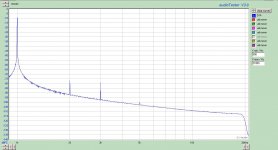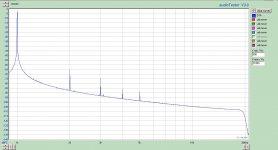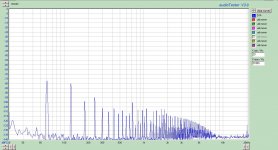It does sound like a fun amplifier though.
What is a good example of a popular class A PP that people are building?
Lynn Olsen has a few good designs.
Gary Pimm has his Tabor - but its a rather special case since it uses lots of local feedback and all pentodes.
Allan Wrights PP amps are other good examples - but I don't think they are pure class A - just almost.
Shoog
Shoog,
For class A PP do you have to use a special output transformer? Or is it just manipulation of the anode current? And are PP class A amplifiers run in ultralinear as well or just in pentode?
You can build a Class A PP in what ever flavour you like, Triode, Pentode and UL. The thing is, if you don't want to use gNFB then you are restricted to triode, UL or using Schade type feedback for pentode.
The requirements for the OT are the same as any PP amp. I prefer to run mine at Constant Current so that I can use a zero gapped toroidal OT which minimizes hysteresis in the OT and helps to preserve micro-detail. Its largely up to you what compromises you are prepared to accept.
Shoog
This may be an oversimplification. But if you simply up the quiescent current in a standard PP amp do you force it to stay in class A?
Any PP amp could stray into AB if there is enough drive voltage to send it there. This is equally true of SE.
You have to work out your load line in such a way that neither valve ever reaches zero g1 voltage point. Effectively that requires upping the quietscent current as a consequence.
Shoog
For a fair analysis of the benefits and pitfalls of Class A PP try this;
Class-A Amplifiers explained
Shoog
Class-A Amplifiers explained
Shoog
So the essence of class A is that it is a constant current output stage?
Class A is simply that the drive signal never drives the tube outside of the voltage "envelope", between 0v on the grid and the (-) cutoff voltage of the tube operating point. The positive swing cannot be higher than the (-) bias voltage and the negative swing never takes the tube farther than just short of the cutoff level. The tube always conducts. If the tube is biased too (-) then it will go into the cutoff range too quickly leaving the other tube to do the work during that period. Or doing nothing if it's SE. This normally occurs at high volume drive levels.
What is a good example of a popular class A PP that people are building?
The Oddwatt. This design uses a self-splitting final in the form of an LTP with active tail loading. The active tail load enforces Class A operation. Of course, this does cost you some output.
The essence of Class A is that it never crosses into positive g1 territory. This effectively means that the bias current is roughly half way between zero current and 2x bias current. This is roughly the same as saying that it has constant average current.
Shoog
That's not right. The essence of Class A is that the final(s) never cross into plate current cutoff. You can most surely operate something like the 811 in Class A by using a positive VGK to set a Q-point plate current, then drive it so that the plate current never goes into cutoff.
Of course, you'll need a stiff grid driver that can supply the required grid current. Something like a source follower.
The other thing to keep in mind is that the OPT will need to match the speaker load to 2X (P-2-P) RL / phase, and not the 4X P-2-P you'd need for Class AB (or B or C) finals.
Thanks for clarifying.That's not right. The essence of Class A is that the final(s) never cross into plate current cutoff. You can most surely operate something like the 811 in Class A by using a positive VGK to set a Q-point plate current, then drive it so that the plate current never goes into cutoff.
Of course, you'll need a stiff grid driver that can supply the required grid current. Something like a source follower.
The other thing to keep in mind is that the OPT will need to match the speaker load to 2X (P-2-P) RL / phase, and not the 4X P-2-P you'd need for Class AB (or B or C) finals.
Shoog
Are there any FFT measurements of those?These are absolutely none issues in a PP amp designed to run in Class A. A PP amp can be built as two back to back SE amps and will deliver all of the benefits of SE along with the benefits of PP. In short it can give more than an SE amp.
This is the distortion measurement of Allan Wrights PP-1C
http://www.vacuumstate.com/images_upload/gross/pp_1c_thd_s.gif
I think you will find very little difference between the distortion profile of this PP amp and a typical SE amp (apart from been generally lower with the PP).
The Amity follows exactly the predicted distortion profile anticipated from a good class A PP amp - with low overall distortion and a reduced 2nd harmonic component due to cancellation;
http://usr.audioasylum.com/images/2/24819/distortion_1.jpg
http://www.audioasylum.com/forums/tubediy/messages/13/131515.html
Shoog
http://www.vacuumstate.com/images_upload/gross/pp_1c_thd_s.gif
I think you will find very little difference between the distortion profile of this PP amp and a typical SE amp (apart from been generally lower with the PP).
The Amity follows exactly the predicted distortion profile anticipated from a good class A PP amp - with low overall distortion and a reduced 2nd harmonic component due to cancellation;
http://usr.audioasylum.com/images/2/24819/distortion_1.jpg
http://www.audioasylum.com/forums/tubediy/messages/13/131515.html
Shoog
Last edited:
At what output level?This is the distortion measurement of Allan Wrights PP-1C
http://www.vacuumstate.com/images_upload/gross/pp_1c_thd_s.gif
Those look like typical class AB amp measurement.The Amity follows exactly the predicted distortion profile anticipated from a good class A PP amp - with low overall distortion and a reduced 2nd harmonic component due to cancellation;
http://usr.audioasylum.com/images/2/24819/distortion_1.jpg
Some measurements on the Amity amplifier - arend-jan - Tube DIY Asylum
Zero global feedback amps rarely look anything like that. These are impressive figures for a zero feedback PP amp - equaling and bettering anything a zero feedback SE can achieve.At what output level?
Those look like typical class AB amp measurement.
Shoog
- Status
- This old topic is closed. If you want to reopen this topic, contact a moderator using the "Report Post" button.
- Home
- Member Areas
- The Lounge
- SE distortion


